Table of Contents
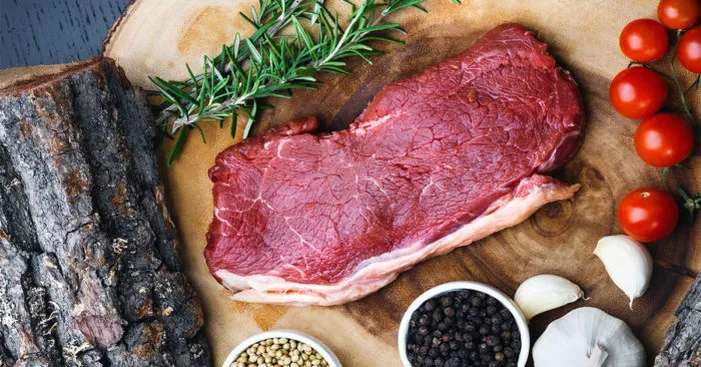
Are you looking for a healthier alternative to beef steak? Look no further than bison steak!
Not only is it lean and packed with essential vitamins and minerals, but it also has a unique, robust flavor that will tantalize your taste buds.
In this blog post, we‘ll explore the amazing benefits and potential side effects of bison steak so you can decide if it‘s the right choice for you.
So get ready to take a journey into the world of healthy and delicious bison steak!
Bison: now and then
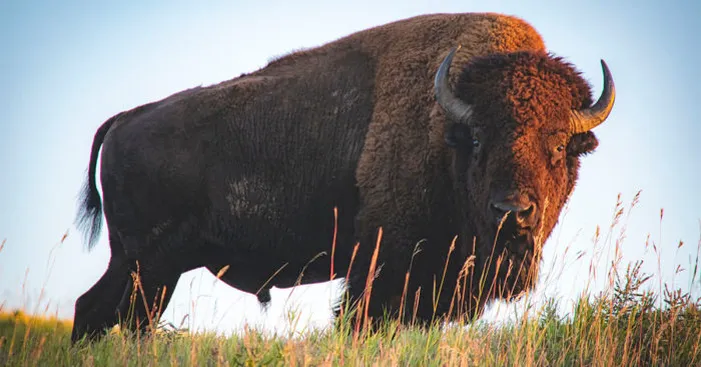
Bison are among the wild herbivorous mammal that lives in the North American pastures.
In the 19th century, this wild bull was almost extinguished due to commercial hunting and the appearance of cow diseases.
Historically, bison used to occupy a triangular region from Mexico South, to the Great Bear Lake in Canada North and the East to the Atlantic Ocean.
Nowadays, these wild animals live in a smaller region mostly in national parks and reserves.
As for the shape, bison are large animals that weigh between 1000lbs and 2200lbs (300Kg to 1ton) and a length of 10ft (3.5m).
They can reach a height of 5ft (1.5meters) from the ground to the shoulders.
Bison have a very thick winter dark brown coat and strong horns that help them survive both the harsh of winter and predators.
As for bison steak, it is very similar to beef since the bison is among the same family as cows.
Generally, you can buy fresh bison steak directly from producers.
Nowadays, with the growing demand for this meat, you are more likely to find it in the butcher’s region of grocery stores.
Benefits of bison steak:
Bison steak calories:
These data count for the recommended daily intake of (70g to 2.5oz) cooked bison steak:

- Calories: 124
- Protein: 18g
- Cholesterol: 49mg
- Fat: 7.3g
- E vitamin: 2%
- B1 vitamin: 7%
- B3 vitamin: 23%
- B6 vitamin: 14%
- B12 vitamin: 31%
- Copper: 5%
- Iron: 13%
- Magnesium: 4%
- Phosphorus: 16%
- Potassium: 7%
- Zinc: 28%
- Selenium: 34%
Bison steak potential Benefits:
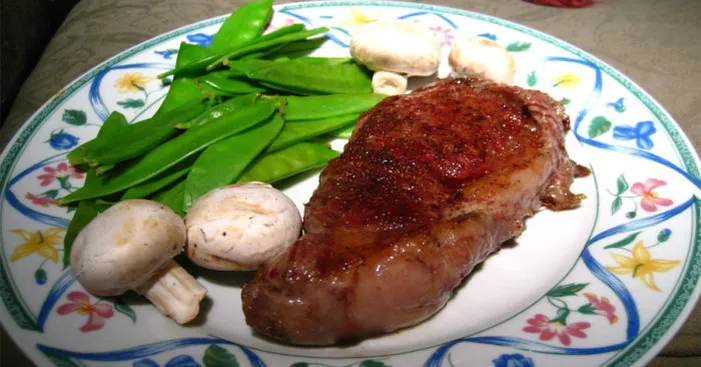
As part of a balanced diet containing different types of food, bison can offer many health benefits including:
Rich in B vitamins:
Only 2.5oz of cooked bison steak (70g) contains about 30%, 14%, and 23% of the daily recommended need in vitamin B12, B6, and B3 respectively.
This group of vitamins is necessary for many cellular functions including energy production and the formation of red blood cells and neurotransmitters.
Even though B vitamins are more available in nowadays food, it is useful to consume bison steaks to meet the RDV.
Good source of protein:
The recommended daily intake of bison steak is 2.5oz (70g) and it offers up to 18g of protein which is 32% of the RDV in protein.
Providing our bodies with its need in protein is essential for many body functions such as hormonal production, tissue generation, and nutrients transfer.
It is quite easy to calculate your RDV in protein, for each pound of bodyweight we need 0.3 to 0.4g of protein daily (0.8g for each 1KG).
For example, if you weigh 150 pounds you’ll need 45 to 60g of protein per day to meet your body’s needs.
Therefore, including bison steaks in your diet will be a great push to your protein intake.
Great source of Selenium, zinc, and iron:
Bison meat is also super-rich in many beneficial minerals including iron, zinc, and mostly selenium.
The recommended daily intake of bison meat offers 13%, 34%, and 28% of iron, selenium, and zinc respectively.
Zinc plays a key role in the metabolism process, helps our immune system, and contributes to wound healing.
Iron, on the other hand, is essential for the overall growth, the creation of hemoglobin, and the transport of oxygen.
Lastly, selenium offers great antioxidant properties which help reduce oxidative stress, the reason for most diseases.
Why is Bison meat leaner than beef?
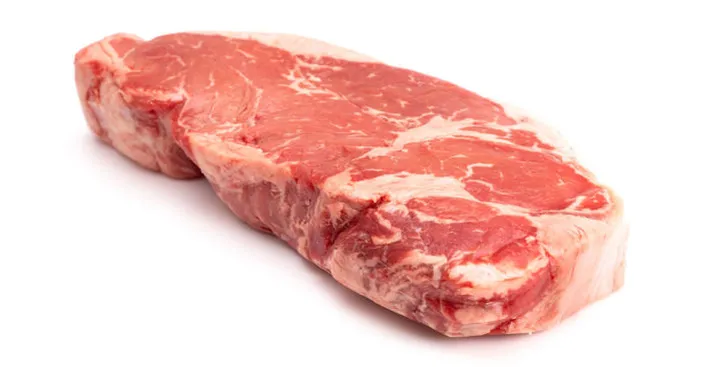
The main reason bison meat is leaner meat than beef is the fat content in the cuts.
Beef meat offers about 23% of our daily need in fat compared to only 14% offered by bison steak for the same quantity.
This is because bison is a very active animal therefore they burn more fat than less active cows.
Also, bison meat contains almost half the amount of cholesterol for the same quantity as beef.
In addition, bison offers almost the same amount of protein that beef offers.
As a result, bison steaks are leaner than beef as it offers the same protein content with less fat and cholesterol.
Another additional reason is that beef is not force-fed either injected with hormones like most processed beef.
Cooking bison steak:
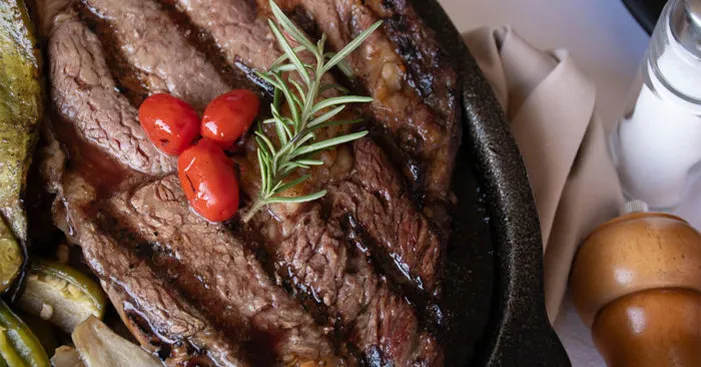
There are several methods and tips for cooking bison including:
- Bison can replace beef steak in any recipe whether if it’s barbecued or used in a stew.
- Since it is leaner than beef, you need to cook bison steak for a shorter time and lower temperature to avoid dryness.
- Depending on the recipe, it is best to reduce the cooking time by about half the time beef needs.
- For example, roasting a beef steak needs an hour, and a bison steak the same size only needs 30 to 35 minutes.
- You can always check the cooking state to obtain perfect juicy bison steaks.
- Sometimes bison steaks can be tough, you can marinate them for 8 hours in a mixture of herbs and spices with an acidic liquid.
- Bison steak combines perfectly with berry sauces such as blueberry, cranberry…
- This type of meat is also very yummy when combined with root vegetables such as sweet potatoes, carrots, beets …
- Use grilled bison steaks instead of beef to make delicious burgers.
- Bison meat is a strong meat which is why it is best to be combine it with strong sauces and spices.
Precautions before you consume bison steaks:

Bison and wild herbivorous meat such as rabbit meat, are very good for health if consumed moderately.
However, due to the diet of these animals, you should avoid overcooking to avoid the formation of toxic compounds.
In addition, bison steak is not healthy for people suffering from gout due to the high content of purine.
Here are the precautions you need to consider before you eat bison meat:
Beware of overcooking:
When meat is cooked at a high temperature, certain carcinogenic compounds may form including HCAs and PAHs.
These harmful elements form depending on the cooking method and the temperature of cooking.
For instance, frying, barbecuing, and grilling produce the most carcinogenic content.
On the other hand, baking, simmering or roasting produce a negligible amount.
Several studies showed a link between overcooked meat and many types of cancer.
To sum things up, make sure you cook bison steaks enough to kill bacteria without browning the skin.
If the skin of the bison steak turns brown, it is more likely to contain carcinogenic elements.
Cadmium content:
Cadmium is a harmful mineral to the human body as it can be toxic and even fatal in some cases.
This mineral usually exist in large quantities in the meat of wild herbivorous animals.
For example, the kidneys and liver of moose, deer, and bison are usually contaminated with cadmium.
Some researchers linked that contamination to the consumption of lichen which is a plant exposed to air pollution.
However, this is not the case for farmed bison as they don’t present any cadmium contamination.
As precaution measures, specialists advise avoiding consuming offal from wild animals.
This warning is more important to those who are more vulnerable to cadmium such as smokers.
These precautions are not limited to smokers, the elderly, pregnant women, people with chronic disease, and children should also avoid consuming wild animal offal.
Why bison steaks are not popular?
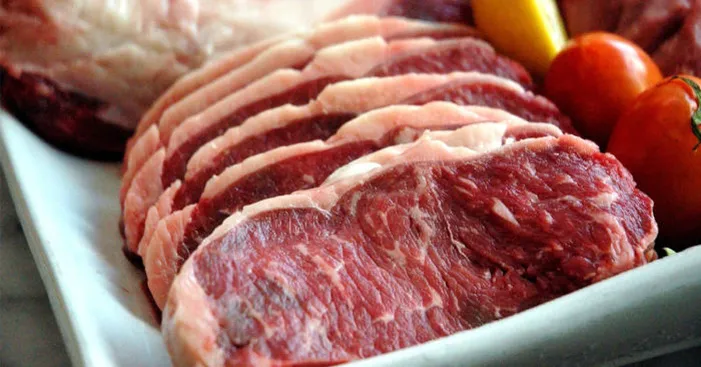
Bison steaks are full of nutritional virtues and versatile in the kitchen but it is not that famous due to few possible reasons.
First, this type of meat may seem a bit more expensive than beef or chicken and a little difficult to cook.
Bison steaks are commonly consumed grilled or cooked like other types of red meat.
Bison steak is expensive:
The most common obstacle to consuming bison steak regularly is the high price.
This meat is fairly expensive because of the market prices set concerning demand and supply.
In addition, the prices of grass-fed bison are higher than the cost of grass-fed beef.
However, the cost of conventionally raised bison is slightly lower due to the large-scale farming.
Nonetheless, farmed bison don’t necessarily contain all the nutritional values found in wild bison.
You can still avoid the high cost by purchasing large quantities to get a discount or buy it when it’s on sale.
Bison steaks can easily be overcooked:
Due to the low-fat content in bison compared to beef, it is very likely to overcook it, which results in a tough, dry, and hard-to-chew meal.
While that mostly applies to large cuts such as bison steaks, ground bison also require less cooking than ground beef.
You can avoid overcooking bison meat by reducing the cooking temperature or lower the flame.
Just like when you first try new recipes, it may take some time to master cooking bison as you want it.
But, once you do, it will definitely be a worthy effort!
Buying bison steak:
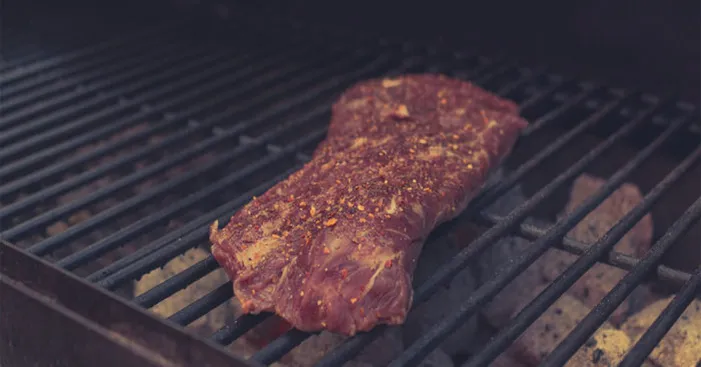
There is a lot of things to look at when you are purchasing bison meat.
Kirk Biondi, the executive chef at a New York City restaurant (Ted’s Montana Grill) that serves burgers and bison steaks offers great tips.
Biondi recommends looking for fresh bison steaks sold the same day they made it to the store.
If that is not an option, choose fresh and unfrozen cuts as the meat spoils easily if it exposes to heat after being frozen.
Now for the quality, you should look for super red (more than beef) bison steaks with little to no fat as it is a sign of freshness.
According to the Bison producers of Alberta, bison meat must be quickly cooled after purchase to avoid any possible contamination.
Storing bison steak:
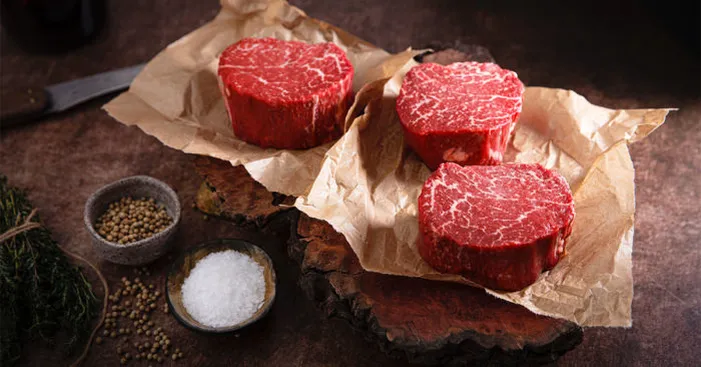
Just like with every type of meat, Bison should be kept refrigerated at all times and consumed quickly after purchase.
This is because meat provides a fertile environment for parasites and bacteria therefore it spoils fast.
As for the shelf life of bison, it depends on the condition of storage and under which the animal grew.
Also, the hygiene of the slaughter process has a big impact on the lifespan of bison steaks.
Therefore, we must consume any type of meat including bison not longer than 2 to 3 days after purchase.
When you go grocery shopping, make sure you choose bison steak last to avoid breaking its cold chain.
First, place it in an airtight bag during the time of transport than in the coldest part of the refrigerator on its original package.
Conservation of bison steak in the refrigerator:
Bison steaks on their original package in the refrigerator can remain safe to eat up to 3 days after your purchase.
However, the more the meat is processed the less refrigeration lifespan it has.
For instance, bison steaks cut into cubes should only be kept for 2 days in the refrigerator.
As for the cooked bison meat, you can refrigerate it for up to 4 days by wrapping it in plastic or aluminum foil.
Conservation of steak in the freezer:
Now if you want to keep bison steak for a longer period, you can freeze them on their original package for up to 4 months.
You can add a layer of plastic foil or an airtight freezing bag to the original package to ensure a better resistance against spoilage.
Bison steaks cut into cubes have a shorter freezing life of 3 months.
